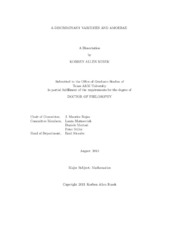| dc.description.abstract | The motivating question behind this body of research is Smale’s 17th problem: Can a zero of n complex polynomial equations in n unknowns be found approximately, on the average, in polynomial time with a uniform algorithm?
While certain aspects and viewpoints of this problem have been solved, the analog over the real numbers largely remains open. This is an important question with applications in celestial mechanics, kinematics, polynomial optimization, and many others.
Let A = {α_1, . . . , α_n+k } ⊂ Zn. The A-discriminant variety is, among other things, a tool that can be used to categorize polynomials based on the topology of their real solution set. This fact has made it useful in solving aspects and special cases of Smale’s 17th problem. In this thesis, we take a closer look at the structure of the A-discriminant with an eye toward furthering progress on analogs of Smale’s 17th problem. We examine a mostly ignored form called the Horn uniformization. This represents the discriminant in a compact form. We study properties of the Horn uniformization to find structural properties that can be used to better understand the A-discriminant variety. In particular, we use a little known theorem of Kapranov limiting the normals of the A-discriminant amoeba.
We give new O(n^2) bounds on the number of components in the complement of the real A-discriminant when k = 3, where previous bounds had been O(n^6) or even exponential before that. We introduce new tools that can be used in discovering various types of extremal A-discriminants as well as examples found with these tools: a family of A-discriminant varieties with the maximal number of cusps and a family that appears to asymptotically admit the maximal number of chambers. Finally we give sage code that efficiently plots the A-discriminant amoeba for k = 3.
Then we switch to a non-Archimedean point of view. Here we also give O(n^2) bounds for the number of connected components in the complement of the non- Archimedean A-discriminant amoeba when k = 3, but we also get a bound of O(n^(2(k−1)(k−2)) )when k > 3. As in the real case, we also give a family exhibiting O(n^2) connected components asymptotically. Finally we give code that efficiently plots the p-adic A-discriminant amoeba for all k ≥ 3.
These results help us understand the structure of the A-discriminant to a degree, as yet, unknown. This can ultimately help in solving Smale’s 17th problem as it gives a better understanding of how complicated the solution set can be. | en |


